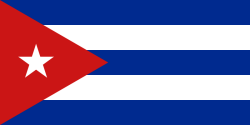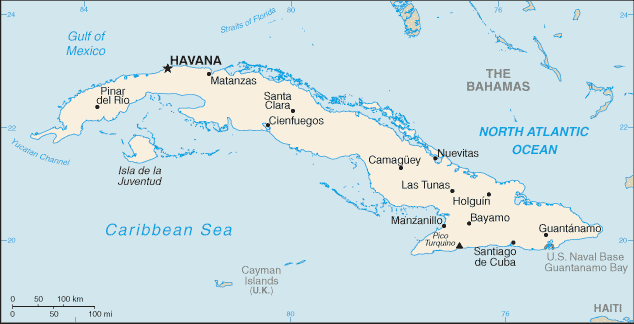Republic of Cuba
Related Categories:
 Flag of Cuba
Flag of CubaFive equal horizontal bands of blue (top, center, and bottom) alternating with white; a red equilateral triangle based on the hoist side bears a white, five-pointed star in the center. |
 Cuba - Fotw
Cuba - FotwThe Flag, History of the Flag, Construction Sheet, Vertical Flag.
www.fotw.us/
Cuba is the most populous country in the Caribbean. Its culture and customs draw from several sources including the aboriginal Taíno and Ciboney peoples, the period of Spanish colonialism, the introduction of African slaves, and its proximity to the United States.
en.wikipedia.org/
Cuba is a multiracial society with a population of mainly Spanish and African origins. The largest organized religion is the Roman Catholic Church, but evangelical protestant denominations continue to grow rapidly. Afro-Cuban religions, a blend of native African religions and Roman Catholicism, are widely practiced in Cuba. Officially, Cuba has been an atheist state for most of the Castro era. In 1962, the government of Fidel Castro seized and shut down more than 400 Catholic schools, charging that they spread dangerous beliefs among the people. In 1991, however, the Communist Party lifted its prohibition against religious believers seeking membership, and a year later the constitution was amended to characterize the state as secular instead of atheist.
While the Cuban constitution recognizes the right of citizens to freedom of religion, the government de facto restricts that freedom. Twenty-two denominations, including Presbyterians, Episcopalians, and Methodists, are members of the Cuban Council of Churches (CCC). Most CCC members are officially recognized by the State, though several, including the Evangelical Lutheran Church, are not registered and are recognized only through their membership in the CCC. Another 31 officially recognized denominations, including Jehovah's Witnesses and the small Jewish community, do not belong to the CCC. The government does not favor any one particular religion or church; however, the government appears to be most tolerant of those churches that maintain close relations to the State through the CCC. Unregistered religious groups experience various degrees of official interference, harassment, and repression. The Ministry of Interior engages in active efforts to control and monitor the country's religious institutions, including through surveillance, infiltration and harassment of religious professionals and practitioners. The most independent religious organizations--including the Catholic Church, the largest independent institution in Cuba today--continue to operate under significant restrictions and pressure imposed on them by the Cuban regime. The Cuban Government continues to refuse to allow the church to have independent printing press capabilities; full access to the media; to train enough priests for its needs or allow adequate numbers of foreign priests to work in the country; or to establish socially useful institutions, including schools and universities, hospitals and clinics, and nursing homes. All registered denominations must report to the Ministry of Interior's Office of Religious Affairs.
The visit of Pope John Paul II in January 1998 was seen as an important, positive event for bringing a message of hope and the need for respect of human rights. Unfortunately, these improvements did not continue once the Pope left the island. While some visas were issued for additional priests to enter Cuba around the time of the visit, the regime has again sharply restricted issuance of visas. Moreover, despite explicit regime guarantees and repeated follow-up requests, the regime has refused to permit the Catholic Church to establish Internet connections or an intranet among dioceses on the Island. In a pastoral letter entitled "There is No Country Without Virtue" ("No Hay Patria Sin Virtud"), the Cuban Conference of Catholic Bishops in February 2003 openly criticized the government's strict control over the activities of the Catholic Church, especially state restrictions on religious education and Church access to mass media, as well as the increasingly amoral and irreligious character of Cuban society under Communist rule.
Other Cuban religious groups--including evangelical Christians, whose numbers continue to grow rapidly--also have benefited from the relative relaxation of official restrictions on religious organizations and activities. Although particularly hard hit by emigration, Cuba's small Jewish community continues to hold services in Havana and has members in Santiago, Camaguey, and other parts of the island. See also the Department's report on international religious freedom for further information.
www.state.gov/r/
Introduction
About
Contact
Symbols in The News
Interpret this Symbol
AAC
African
AI
Alchemy
Alphabets
Ancient
Animal Symbolism
Architecture
Art
Articles
Astrology
Baha'i
Blissymbolics
Blueprint Symbols
Buddhist
Celtic Symbols
Cemetery
Chinese Symbols
Christian
Circle
City
Codes
Color
Conlangs
Crop Circles
Danger
Da Vinci Code
Designing Logos
Dictionaries
Dreams
Education
Egyptian Symbols
Electrical
Emoticons
Find Images
Fonts
Food
Fraternity
Hamsa
Healing
Heraldry
Hermetic
Highway Signs
Hindu
History
Hobo
Holiday
Icons
iConji
Islamic
Jain Symbols
Japanese, Kanji
Jewish
Justice
Law
Literary Symbolism
Mandalas
Map
Masonic
Math, Number
Meaning of Names
Medical
Middle East
Military
Miscellaneous
Money
Music
Mythology
Native American
Playing Cards
Power
Psychology
QiQiiKhu
Reiki
Religious
Runes, Norse
Sacred Geometry
Scientific
Science Fiction
Sorority
Sports
Symbols in the News
Tattoos
ThirteenSymbols
Tree of Life
Ursprache
Videos
Visual Languages
Weather
Web Codes
Wicca
Words
Writing Systems
Braille
Coinherence
Coptic
Cuneiform
Easter Island
Etruscan
Happy Human
Hebrew
Kokopelli
Linear B
Lotus
Love Symbols
Mandorla
Moon Alphabet
Nine Pointed Star
Om
Oz
Phonetic
Scarab Beetle
Silent
Theosophy
Unifon
About
Contact
Symbols in The News
Interpret this Symbol
AAC
African
AI
Alchemy
Alphabets
Ancient
Animal Symbolism
Architecture
Art
Articles
Astrology
Baha'i
Blissymbolics
Blueprint Symbols
Buddhist
Celtic Symbols
Cemetery
Chinese Symbols
Christian
Circle
City
Codes
Color
Conlangs
Crop Circles
Danger
Da Vinci Code
Designing Logos
Dictionaries
Dreams
Education
Egyptian Symbols
Electrical
Emoticons
Find Images
Fonts
Food
Fraternity
Hamsa
Healing
Heraldry
Hermetic
Highway Signs
Hindu
History
Hobo
Holiday
Icons
iConji
Islamic
Jain Symbols
Japanese, Kanji
Jewish
Justice
Law
Literary Symbolism
Mandalas
Map
Masonic
Math, Number
Meaning of Names
Medical
Middle East
Military
Miscellaneous
Money
Music
Mythology
Native American
Playing Cards
Power
Psychology
QiQiiKhu
Reiki
Religious
Runes, Norse
Sacred Geometry
Scientific
Science Fiction
Sorority
Sports
Symbols in the News
Tattoos
ThirteenSymbols
Tree of Life
Ursprache
Videos
Visual Languages
Weather
Web Codes
Wicca
Words
Writing Systems
Braille
Coinherence
Coptic
Cuneiform
Easter Island
Etruscan
Happy Human
Hebrew
Kokopelli
Linear B
Lotus
Love Symbols
Mandorla
Moon Alphabet
Nine Pointed Star
Om
Oz
Phonetic
Scarab Beetle
Silent
Theosophy
Unifon
